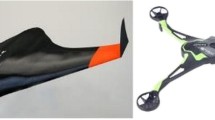Abstract
Future unmanned aerial vehicle applications require the development of new advanced design environments. To get an effective unmanned aerial system, UAS, solution, it is necessary to take into account all elements of the system, e.g., to bring together aircraft design, payload, communication and other elements into one multidisciplinary design process. Compared to manned aircraft, an unmanned aerial vehicle, UAV, interacts with the environment through the onboard sensors. Therefore, the sensor and communication performances as well as their implementation in the whole system play an important role in mission fulfillment. To take the interaction with the operational environment into account, this operational environment is simulated during the design and assessment process. Owing to the high resolution and elevation-based terrain data, geometry representation of the UAS elements and its interaction with the environment, the sensor and communication performance is simulated, evaluated and fed back into the aircraft design process. For this, the following data are obtained during the mission simulation for the evaluation: height of the terrain, sensor coverage area, presence of uncovered areas, slant range to the ground or objects of interest, obstacles in line of sight, probability of an object detection and detection of the camera field of view limitations.










Similar content being viewed by others
Abbreviations
- ACR:
-
Area coverage rate
- b :
-
Sensor ground swath width
- d c :
-
Object characteristic dimension
- E :
-
Required energy for a mission
- EACI:
-
Energy-rated area coverage index
- f :
-
Degradation factor
- FOV:
-
Field of view
- ƒ :
-
Focal length of the camera
- GSD:
-
Ground sample distance
- GSDH :
-
Horizontal ground sample distance
- GSDV :
-
Vertical ground sample distance
- h :
-
Vertical distance from the sensor installed on the UAV to the ground
- H :
-
Height of the object
- HFOV:
-
Horizontal field of view
- Hpix:
-
Number of horizontal pixels of the camera
- LOS:
-
Line-of-sight vector of the camera
- N :
-
Number of cycles across the target
- P :
-
Distance between pixels of the camera
- P():
-
Probability of achieving target discrimination task
- R :
-
Slant range
- UA:
-
Unmanned aircraft
- UAV:
-
Unmanned aerial vehicle
- UAS:
-
Unmanned aerial system
- V :
-
Flight velocity
- VFOV:
-
Vertical field of view
- Vpix:
-
Number of vertical pixels of the camera
- W :
-
Width of the object
- θ Look :
-
Angle between the slant range and the sensor height over the ground
References
Göktogan, A.H., Sukkarieh, S., Cole, D.T., Thompson, P.: Airborne vision sensor detection performance simulation. In: The interservice/industry training, simulation and education conference (I/ITSEC’05), pp. 1682–1687. Orlando, FL, USA (2005)
Feger, J., Pozatzidis, F.: Simulationsmodell zur Bewertung der Missionserfuellung Unbemannter Fluggeraete im Vorentwurfsstadium” (Simulation Model for Mission Evaluation of Unmanned Aerial Vehicles in the Preliminary Design Stage). Deutscher Luft- und Raumfahrtkongress, Rostock (2015) (September 22–24)
Srikanth, A., Indhu, B., Krishnamurthy, L., Naidu, V.P.S.: Photoscenery for realistic scene generation and visualization in Flightgear: a tutorial. Int. J. Adv. Res. Electr Electron. Instrum. Eng. 3(Special issue 5), 577–582 (2014) (An ISO 3297: 2007 Certified Organization)
Gimeres, R., Castro Silva, D., Paulo Reis, L., Oliveira, E.: Flight simulation environments applied to agent-based autonomous UAVs. In: Proceedings of the 10th international conference on enterprise information systems (ICEIS), pp. 243–246, Barcelona, 12–16 June 2008
OpenSceneGraph Developer Community. OpenSceneGraph - Features (2017). http://www.openscenegraph.org/index.php/about/features
Bertuccelli, L., Choi, H.-L., Cho, P., How, J.P.: Real-time multi- UAV task assignment in dynamic and uncertain environments. In: Proceedings of AIAA Guidance, Navigation and Control Conference. Chicago (2009) (August 10–13)
Roessler, C.: Conceptual design of unmanned aircraft with fuel cell propulsion system. Ph.D. Dissertation, Technical University of Munich, Garching (2012) (ISBN: 9783843904063)
Perez, D., Maza, I., Caballero, F., Scarlatti, D., Casado, E., Ollero, A.: A ground control station for a multi-UAV surveillance system. J. Intell. Rob. Syst. 69(1–4), 119–130 (2013). https://doi.org/10.1007/s10846-012-9759-5
Dannhauer, T.: Konzeption eines Sichsystemes für einen Flugsimulator unter Berücksichtigung von Zulassungsrandbedingungen (Concept of a visual system for a flight simulator taking into account licensing conditions). Diploma Thesis, Institute of Flight System Dynamics, Technical University of Munich, Garching near Munich, Institute Library (2009)
Herbst, S., Hornung, M.: ADDAM: An object oriented data model for an aircraft design environment in MATLAB. AIAA Modelling and Simulation Technologies Conference. Kissimmee (2015) (January 5–9)
Hochstrasser, M.: Erweiterung einer Hardware-in-the-Loop- Simulation um eine Flugzeug- Visualisierungsumgebung basierend auf OpenGL und Matlab/Simulink (Extension of the hardware-in-the-loop Simulation tool for an aircraft visualization environment based on OpenGL and Matlab/Simulink). Master Thesis, Institute of Flight System Dynamics, Technical University of Munich, Garching near Munich, Institue Library (2012)
OpenSceneGraph Developer Community. osgVisual - Getting Started (2017). https://www.osgvisual.org/wiki/GettingStarted
Gundlach, J.: Designing unmanned aircraft systems: a comprehensive approach. American Institute of Aeronautics and Astronautics, Education Series, Reston, Virginia, USA (2012) (ISBN: 978-1-60086-843-6)
Author information
Authors and Affiliations
Corresponding author
Rights and permissions
About this article
Cite this article
Fokina, E., Feger, J. & Hornung, M. Application of a visualization environment for the mission performance evaluation of civilian UAS. CEAS Aeronaut J 10, 817–825 (2019). https://doi.org/10.1007/s13272-018-0350-z
Received:
Revised:
Accepted:
Published:
Issue Date:
DOI: https://doi.org/10.1007/s13272-018-0350-z




